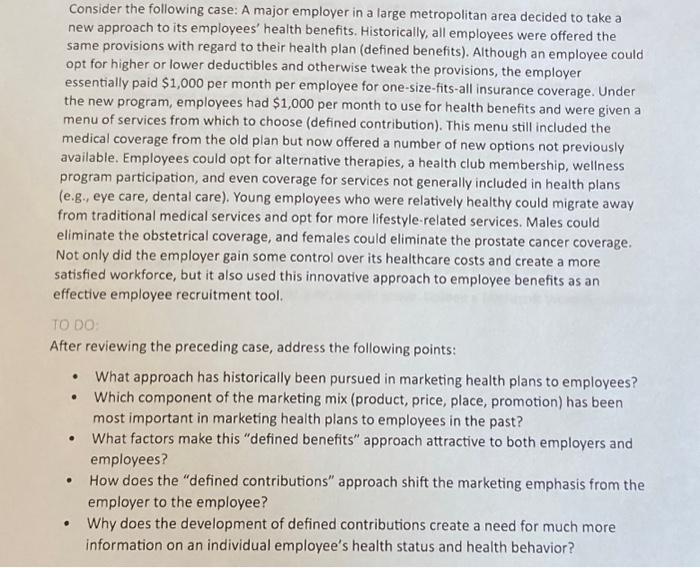Answered step by step
Verified Expert Solution
Question
1 Approved Answer
Consider the following case: A major employer in a large metropolitan area decided to take a new approach to its employees' health benefits. Historically, all
Consider the following case: A major employer in a large metropolitan area decided to take a new approach to its employees' health benefits. Historically, all employees were offered the same provisions with regard to their health plan (defined benefits). Although an employee could opt for higher or lower deductibles and otherwise tweak the provisions, the employer essentially paid $1,000 per month per employee for one-size-fits-all insurance coverage. Under the new program, employees had $1,000 per month to use for health benefits and were given a menu of services from which to choose (defined contribution). This menu still included the medical coverage from the old plan but now offered a number of new options not previously available. Employees could opt for alternative therapies, a health club membership, wellness program participation, and even coverage for services not generally included in health plans (e.g., eye care, dental care). Young employees who were relatively healthy could migrate away from traditional medical services and opt for more lifestyle-related services. Males could eliminate the obstetrical coverage, and females could eliminate the prostate cancer coverage. Not only did the employer gain some control over its healthcare costs and create a more satisfied workforce, but it also used this innovative approach to employee benefits as an effective employee recruitment tool. TO DO: After reviewing the preceding case, address the following points: What approach has historically been pursued in marketing health plans to employees? Which component of the marketing mix (product, price, place, promotion) has been most important in marketing health plans to employees in the past? What factors make this "defined benefits" approach attractive to both employers and employees? How does the "defined contributions" approach shift the marketing emphasis from the employer to the employee? Why does the development of defined contributions create a need for much more information on an individual employee's health status and health behavior?


Step by Step Solution
There are 3 Steps involved in it
Step: 1

Get Instant Access to Expert-Tailored Solutions
See step-by-step solutions with expert insights and AI powered tools for academic success
Step: 2

Step: 3

Ace Your Homework with AI
Get the answers you need in no time with our AI-driven, step-by-step assistance
Get Started


